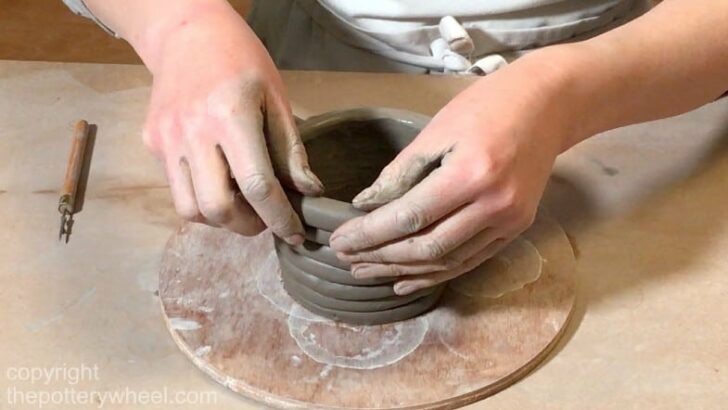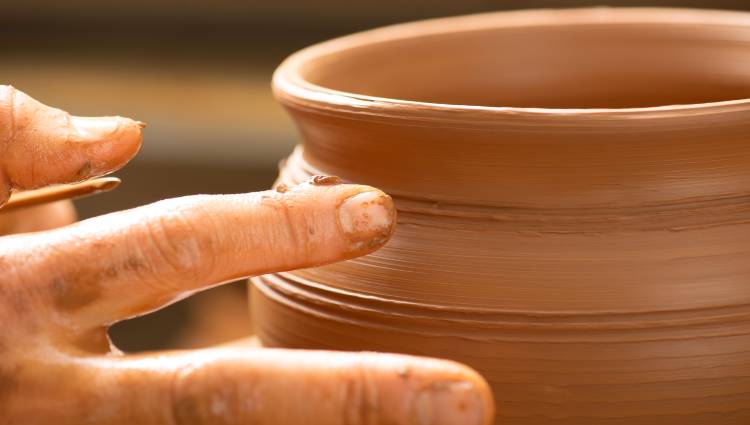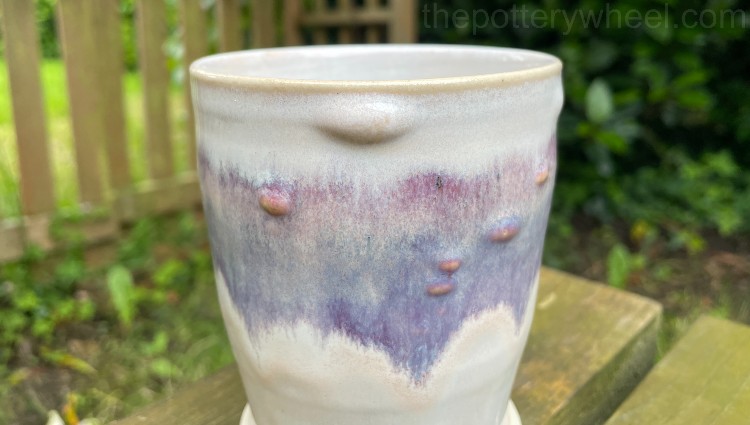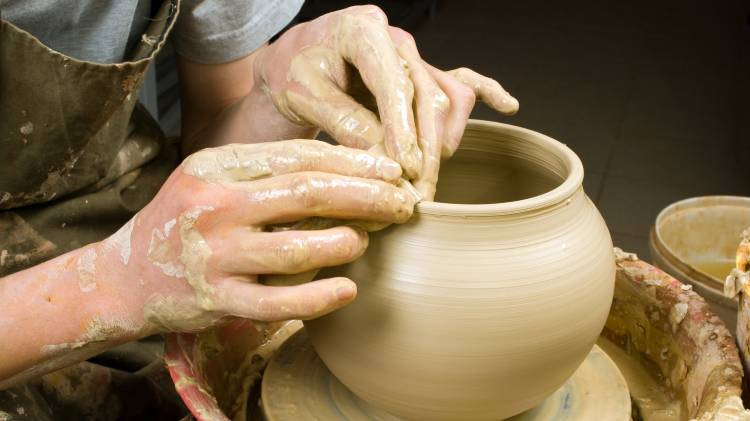The Pottery Wheel is supported by its readers. If you click one of my links, I may earn a commission. I’m also a participant of the Amazon Affiliate Program and will make a commission from qualifying purchases. This helps me keep the website running. Thank you, I really appreciate your support!
When you think of pottery, you might automatically think of ceramics made on a potter’s wheel. However, a lot of really lovely pottery is hand-built, without a wheel. Many hand-building techniques are quite simple. You might need to practice to perfect your style, but that’s part of the fun. This article introduces 4 easy ways to make pottery without a wheel.
It is entirely possible to make lovely pottery without a wheel. Two simple hand-building techniques are coil pots and pinch pots. Molds are great too, these include hump molds, slump molds, and press molds. Slab building is also a simple versatile option. Each approach allows for endless personal style.
I will cover each of the styles listed below. Don’t have time to read the whole article? Just click on the link below to jump to the technique you’re interested in.
Ways to Make Pottery Without a Potters Wheel
It’s sometimes assumed that hand-building pottery without a wheel is the easier option, but that’s not really the case. The more attention you pay to detail the better your ceramics will look when finished.
That being said, these techniques can be adapted to suit all skill levels and all ages. Some hand-building techniques are a great way to introduce children to clay. Don’t feel roped into following these methods to the letter. Get creative!
Also, before you get going, if you’d like to know about the best clay to use to hand-build pottery, check out my post on that subject right here.
How to Make Pottery Without a Wheel – Coil Pots
This technique is probably one of the simplest, most fun ways of hand building pottery without a wheel…
How to Make a Coil Pot
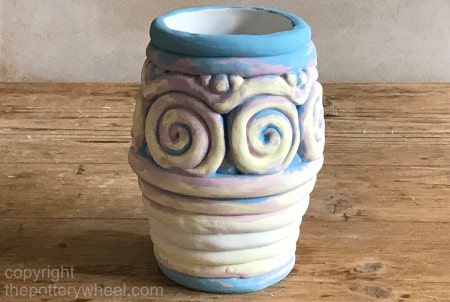
There are lots of different ways to make coil pots. Techniques can range from a very simple 3 coil pot to something much more elaborate. However, what they all have in common is that, not surprisingly, they are made from coils of clay.
I’m going to describe how to make a very simple free-standing coil pot. Then I will go on to describe more complex forms.
Once you have mastered the basics, you can try something more detailed. Mastering the basics means you can experiment and find your own style.
The first thing to learn, when making a coil pot, is how to make coils of clay. This might sound unbelievably basic, but I can tell you that making a coil is a bit of a skill.
First Things First: How to Make a Coil
Potters have different ways of making coils. This method works for me, and I’m describing quite common techniques.
- Take a piece of clay, and roll it into a ball in your hand.
- Once, it’s in a smooth ball, squeeze it into a sausage shape.
- Roll it between your fingers or palms to make it a bit longer.
- Once it is long enough, twist each end of the clay. If you try to roll it without twisting, the coil may flatten as you roll. So, every few rolls, pick up the clay and twist the ends.
- Another tip is that as you roll, move your hands outwards towards the ends of the coil. This movement stretches the clay and it is this that will give you a long coil, rather than a sausage.
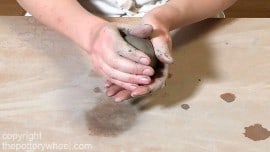
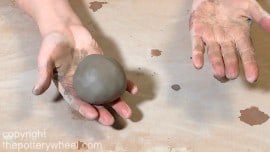
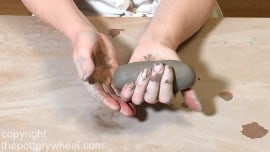
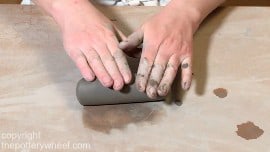
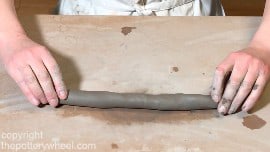
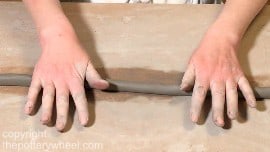
- If you find your coil does flatten a bit and rolling feels awkward, pat it into a round shape. Then use the above trick of twisting the ends, and carry on rolling.
- Also, if you find that you get creases or cracks in your coil, just smooth them out. Carry on rolling, until your coil is about the thickness of your finger. Some potters recommend making the coil finger thick. Others recommend they are the width of your pinky finger. I use a mixture of both.
- You can make a batch of coils before you start building. If you do, then it’s good to cover them with plastic as you work. This stops them from drying out as you are working. I prefer to make them as I go along, as I might alter the thickness a little as I build a pot. Plus, it’s easier on the hands and wrists and you avoid repetitive strain when vary your technique.
Making a Very Simple Coil Pot
Coil pots are a versatile way to make pottery without a wheel. Your coil pot can be very simple or more elaborate.
To make a simple coil pot, it’s best to start out by rolling out some clay with a roller. To get a slab of even thickness, put a wooden dowel on either side of the clay. The width of your batten will determine the thickness of your slab. Or you can use rolling pin guide rings. I use these when rolling out a large slab, but not generally with a small slab like this.
Cut a circle of clay out from the slab, with a needle tool or a craft knife. Smooth out the edges of the clay base with your finger. You may need to wet your finger a bit.
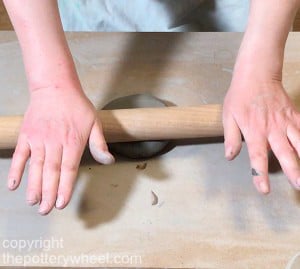
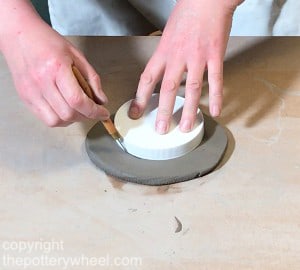
Roll out a coil about the width of your finger. Drape the coil around the base to get an idea of how long it needs to be. Then cut the coil to length. It is best to cut the ends diagonally, so you get a good join. It is hard to join two pieces of clay that are cut square.
A good way to cut diagonally is to lay the two ends of the coil on top of one another. Then cut down diagonally whilst the two ends are aligned.
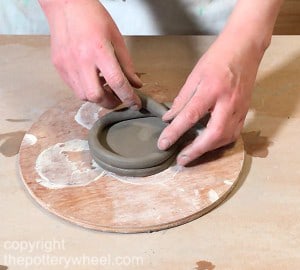
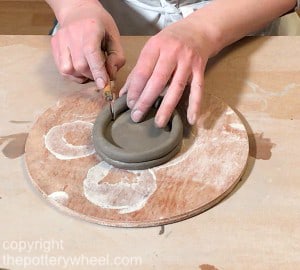
Joining the Coil to the Base
You can’t just press the coil against the base and expect it to adhere completely. If it is just pressed against the base, it will separate when the clay dries or is fired. You need to attach it securely, and you can do this in one of two ways.
Firstly, you can slip and score the two surfaces and press them together. This technique involves scratching the surface of the clay with a needle tool and then wetting the scratched surface.
When you dab water onto the scratched surface, you create clay slip, which acts as glue. You scratch and slip each surface, and then press them together firmly. Then you smooth out the sides of the clay to conceal the join.
Secondly, you can join the coil and the base by smearing the inside of the coil into the base. You can smear using your thumb or the round end of a wooden tool. It’s also fine to smear the outside of the coil so that the pot appears smooth on the outside.
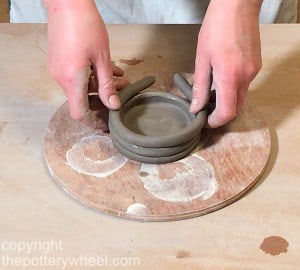
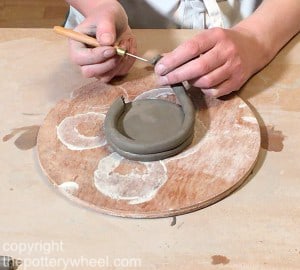
It is a creative decision if you want the coils on your pot to be visible or not. I like the coil detail, so I smear and smooth on the inside.
Repeat the process of adding coils on top of one another, until you have reached a height that you like. Make sure to secure each coil as you go along, by either smearing or using slip and score.
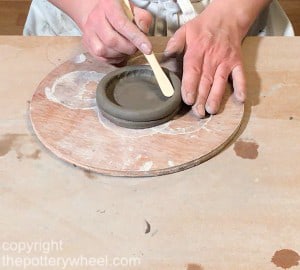
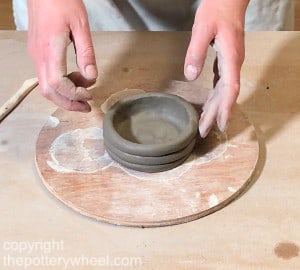
Drying your Coil Pot
Once you have reached the desired height, you need to let your clay dry out. You need to let your pottery dry slowly. This applies whether you are using clay that you can fire or air-dry clay. Coil pots naturally have variations in thickness along the sides of the pot. And there are plenty of joins.
Variations in thickness and joins can be points of weakness and tension in a clay pot. These points can cause cracking if the pot dries too quickly.
So, cover your clay up loosely with a plastic bag to start off the drying process. Over the course of a few days, gradually open the bag up to allow more dry air into the bag. After about 5 days, your pot will be ready to fire or paint. Drying time does depend on how humid the atmosphere is.
More Complicated Coil Pots
Pottery without a wheel need not be plain. And you can add interest and personality to your coil pot using the following techniques.
Create interesting shapes by varying the width of your pot. You can make the pot wider by adding the coil to the top outer edge of the coil below. By doing this with a few successive coils you can create a nice curve outward on your pot.
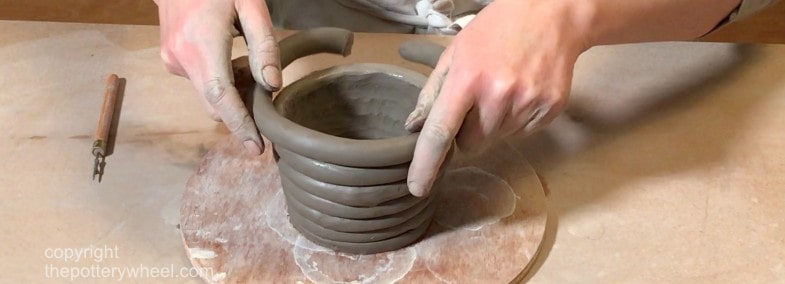
Equally, you can make your pot narrower by adding your coil to the inside top edge of the lower coil.
It is easy to add design detail to your hand-built pot by adding swirls, balls, and lines of clay. As long as you secure your pieces of clay together well, you can add whatever kind of detail you like.
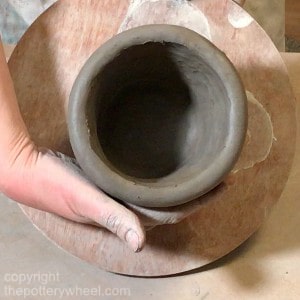
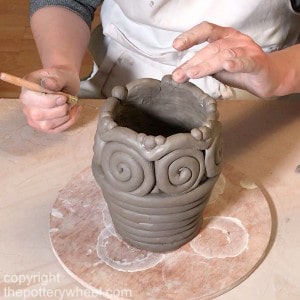
If you want your pottery to hold water, you need to fill in any gaps between design details. For example, you may put two swirls side by side leaving a little gap between them. If this is the case, then be sure to plug the hole up with clay.
Finishing Touches
When you make coils, you are stretching your clay out and making it work quite hard. It’s not uncommon for small cracks to appear on the surface of your clay. This is normal and nothing to worry about.
However, once you have finished your piece it’s a good idea to smooth out these cracks. If you don’t they make widen as the pot dries or is fired. Also, it makes the finish of your pot look nicer.
You can smooth them out with your finger. Or by wetting a soft-haired brush and running that across the surface of your pot until the crack has gone.
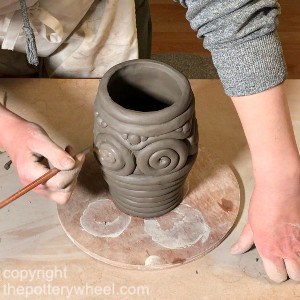
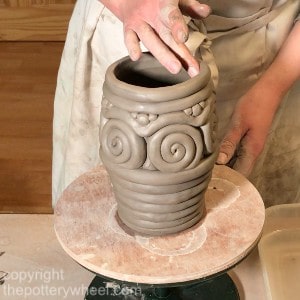
Don’t use a sponge to wet your clay. When you wet the clay, you create slip. The slip contains all the nice fine particles of clay that give your pottery a nice smooth-looking finish. Sponges soak up the slip leaving behind the larger grittier particles of grog. So, smoothing out cracks with a sponge can leave a gritty finish.
How to Make Pottery Without a Wheel – Pinch Pots
The second method of making pottery without a wheel also requires no additional equipment. All you need is some clay and a willingness to try it out…
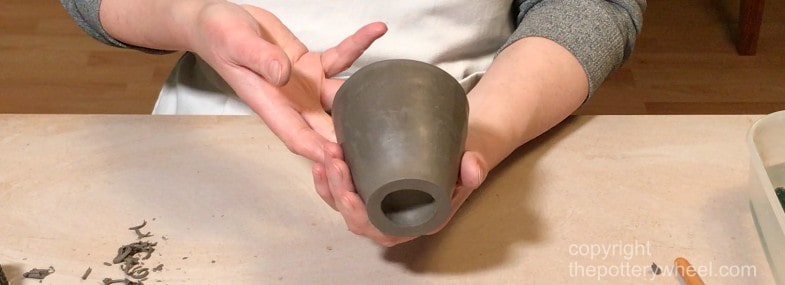
Making a Pinch Pot
Pinch pots1 are a very simple way of handing building pottery without a wheel. So, they are great if you are just starting out and getting the feel for clay.
It’s also a great technique for children. Little fingers like to get in there and give the clay a good old pinch.
Making a Simple Pinch Pot
Take a lump of clay and roll it into a ball. If you are starting out, a good size is a ball that sits comfortably in the palm of your hand. For an adult, this is about the size of an apple or tennis ball. But would be smaller for a child.
Roll it into a ball by rolling it around on the table, and patting it into shape with your hands. Smooth out any lines or imperfections in the clay with your thumb.
Opening up Your Pinch Pot
Support the ball of clay in one hand. Then press the thumb of your other hand into the center of the clay. You can also press in with two thumbs if you’d prefer, but one thumb gives you more control.
Keep pressing your thumb until you feel that it is deep enough into the ball. You want the clay between your thumb and supporting hand to be 1/3 to ½ inch thick. This might be tricky to gauge when you are new to pinch pots. However, you will develop a feel for how thick the clay is.
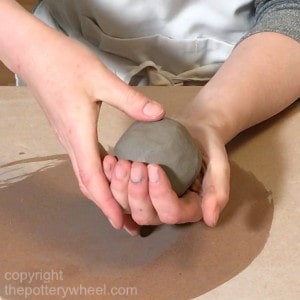

Once your thumb is deep enough, then you can start to open your pinch pot up. You do this, not surprisingly by pinching the clay. When pinching, you don’t pinch with the tips of your fingers. Rather you pinch with the sides of your thumb and pointing forefinger.
Using your thumb and fingers like a crab’s claw, pinch the sides of the clay ball. This will start to open the clay ball out into a pot shape.
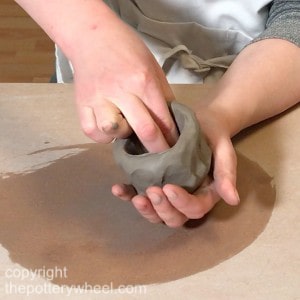
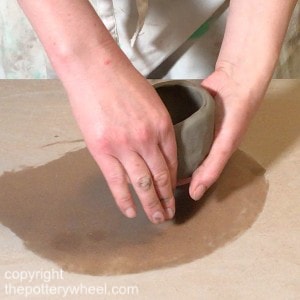
Some potters prefer to have their thumb in the pot and fingers on the outside. I don’t have strong wrists, so I find it easier to start pinching with my finger(s) in the pot. As the pot opens up, I will switch to using my thumb inside. You can mix it up and use the way that feels easiest to you.
Pinch the clay out until the walls of the pot are also about 1/3 to ½ inch thick. This is about the thickness of your finger. If you want your pot to be a bit more refined, you can pinch it to the width of your pinky finger.
Finishing Your Pinch Pot
If you find that the pot is getting wider than you wanted it to, you can squeeze in the sides a bit. This will narrow it up again.
You can give your pot a flat base. This will enable it to sit in a more stable way on the table. Do this by gently tapping the base of your pinch pot on your work surface when the clay is workable.
Similarly, you can even out the rim of your pot, by tapping the rim of your pot on the table.
Smooth the sides of your pinch pot down with your thumbs and fingers. You can also smooth it down with a rubber rib.
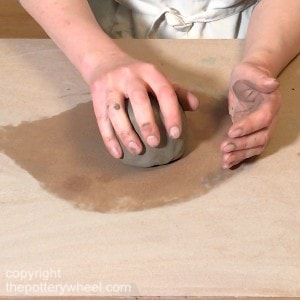

Once you are happy with the way your simple pinch pot looks, you start to dry it out. Dry it slowly to avoid cracks.
When it has dried you can fire and glaze it, or paint it if you are using air-dry clay.
Making a Fancy Pinch Pot
The pinch pot method is deceptively simple. It can take a few attempts to make something you are happy with. Once you’ve mastered this way of hand-building pottery without a wheel, you may want to build on your technique.
Start off your pot in the same way that you would a simple pinch pot. Then if you want to add some height to your pot, you can add an extra coil of clay. Make a coil of clay (as described above).
Cut your coil to length and slip and score the rim of your pinch pot and one edge of your coil. Press the coil against your pinch pot rim and join the ends together.
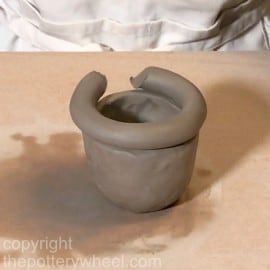
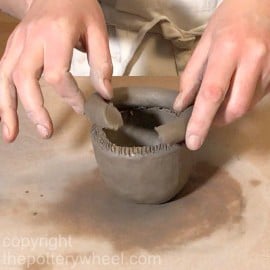
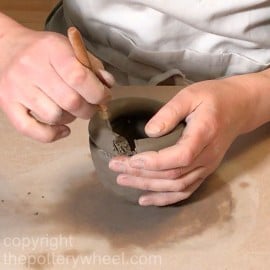
Blend the outside of the coil to the outside of the pot with your thumb, fingernail, or wooden tool. Repeat this process on the inside, blending the coil and pot on the inside too.
Once the coil is securely attached, you can pinch this extra clay. You can either use the extra clay to bring the pot upwards or outwards. If you bring the clay upwards, you can use extra height to make a taller cup shape. However, if you bring the clay outwards, you can make a bigger bowl.
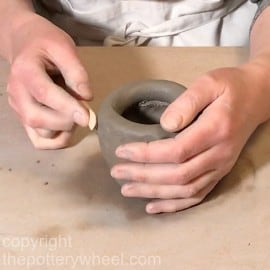
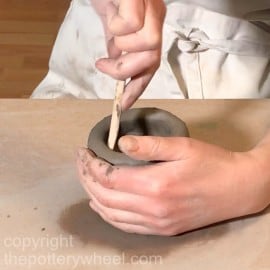
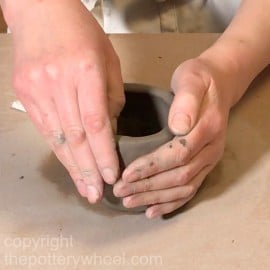
Work on your pot until it is the height or width that you are happy with. Then you can smooth out the surface of your pinch pot.
Smoothing the Pinch Pot Surface
There are several ways you can smooth the surface of your pinch pot. The technique you choose depends on how refined you want your pot to look.
If you prefer a more hand-built textured look, then running a rib tool across the surface might be enough.
To smooth the outside, put your fingers of one hand inside the pinch pot. Then gently draw the rib tool across the surface of the pot. The rib tool will even out any surface bumps and imperfections.
When smoothing the inside, you can support the pot in one hand, or rest it on a piece of foam. Then use the rib tool to smooth the inside. It can be tricky to get the tool in the pot if it has high sides. If so, you can smooth out bumps by wetting a brush and running that over the inside surface.
However, if you want your pinch pot to have a smoother surface, you can follow these steps:
- Leave the pot uncovered overnight so that it becomes leather hard.
- Using a shredder, you can scrape off any bumps and lumps in your clay until it is even.
- You can use a long thin shredder for the inside of the pot if it is tall and thin.
- Then use a metal rib or a credit card to smooth out the scratch marks made by the shredder.
- Finally use a softer rib, something like a rubber rib to make a smooth finish.
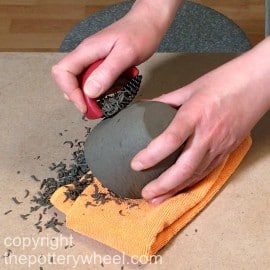

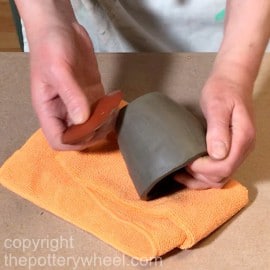
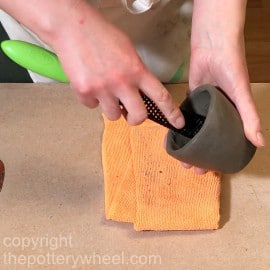
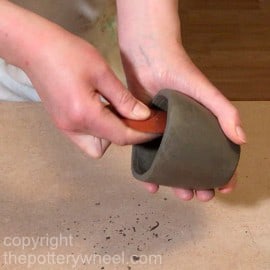
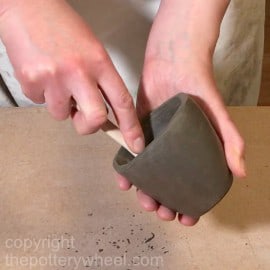
Evening up the Rim of Your Pinch Pot
Use a needle tool to score on the pottery where you want the rim to be. You can do this by putting your pot on a banding wheel. Then holding your hand steady, spin the banding wheel and mark the rim with the needle tool as it spins. You can hold your hand steady by propping it up with a wooden tool or a piece of wooden dowel.
Once you are happy with the position of the rim, you can trim off the uneven excess with your scraper. As with the sides, you can then tidy up the rim with a metal rib or credit card. Then use a soft rubber rim.
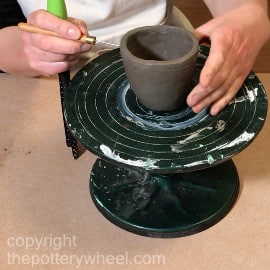
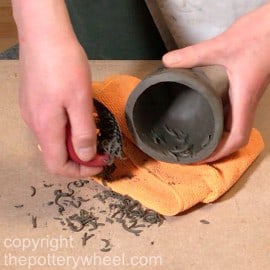
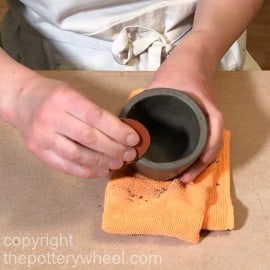
The final touch to the rim is to run around it with a small damp piece of chamois leather. Firmly but gently pinch the rim as you do this, compressing the clay particles. This creates an even rim and reduces the chance that a crack will develop as the pot dries.
Making a Foot Ring
- Turn your pinch pot upside down, so it is sitting on its rim.
- Make a coil of clay about the width of your pinky finger.
- Drape the coil around the base of your pot, to gauge where you want the foot ring to be.
- Mark out the best position for your foot ring with a needle tool.
- Cut the coil the right length, and join the ends using slip and score. Shape the foot ring, and drape it across the base of the pot where you want it to be attached.
- Leave the pot and ring overnight in a loosely covered bag. After 24 hours the foot ring and pot will be leather hard.
- Once leather hard, mark on the base of the pot where the ring will be positioned. Then slip and score the ring and the base. Press the foot ring to the base, and blend the clay of the ring to the base.
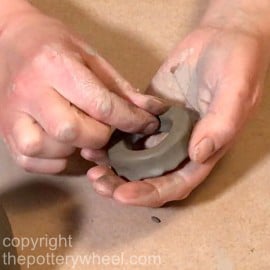
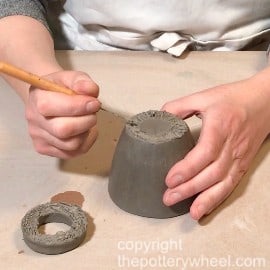
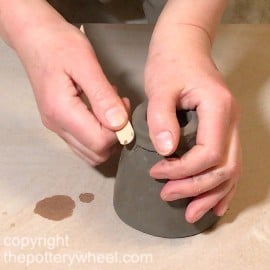
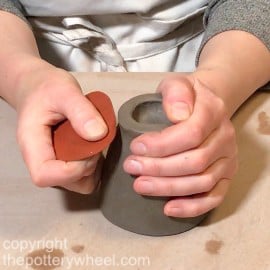
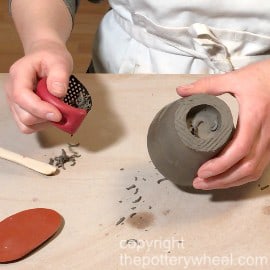
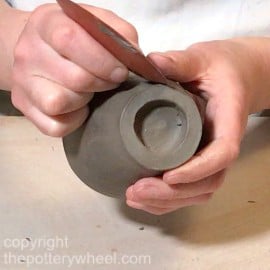
Decorating Your Pinch Pot
There are many ways of decorating your pinch pot. Here are some suggestions:
- Decorating with various underglaze techniques and then covering with a clear glaze
- Bisque firing and glazing
- Make patterns on the surface by indenting, incising, or scoring
- Slip trailing
- Adding clay details
How to Make Pottery Without a Wheel – Using Molds
The first two techniques I have described require that you use only clay and your creativity. With this third method of hand building pottery without a wheel, you will be using a mold.
However, you can still keep this method simple, by using an every day household object as a mold. Read on to find out more…
Pottery Molds
There are lots of different ways you can use molds to make pottery without a wheel. Here are just a few ways of hand building pottery, that make use of different styles of mold.
How to Use a Hump Mold
The idea of hump mold pottery is that you drape a slab of clay over a mold. Then after shaping a little and trimming you leave the pot to dry before tidying it up and firing it. You are using the mold to support the clay and give it shape. Let’s take a closer look at this technique…
A lot of things can be used as hump molds. You can buy them or make them, or simply use an item that you already have that fits the bill. They can be made of a range of materials, including plaster, wood, MDF, and plastic.

In this demonstration, I am using a plaster mold that I made myself. If you are using something like a mixing bowl or a cereal bowl, it’s good to remember the following two guidelines:
- Ideally, you want a bowl with a completely smooth base and no lip. This is because whatever shape your bowl has, your clay will adapt too.
- Choose something with a little bit of flex in it. This will make it easier to remove the mold from the clay when the clay is leather hard.
- If you use a mold that is completely rigid like a Pyrex dish, you might have difficulty removing the clay. You can move a mold with a little bit of flex to separate it from the side of the clay and break the seal.
- Whatever shaped mold you use, make sure that the edge of the mold is the widest part. If your rim is narrower than the body of your mold, you create an undercut. If you mold your clay around the narrow rim, your mold will get stuck in your pottery and won’t pop out.
What You Will Need:
- Clay
- A plaster mold that you have made or bought, or…
- A bowl or dish of some kind. In theory, this can be made of ceramics, glass, or plastic. I have found plastic bowls with a little flex work best. This is because it is easier to pop the leather hard clay off the mold if it is a little flexible. If your pot is on the large side, it can be harder to remove from Pyrex or rigid plastic.
- A roller
- A can or container of some kind to rest your inverted bowl on. This can be anything from a coffee jar to a bottle of glaze. As long as it is relatively stable.
- It would be useful to have a banding wheel, but not essential.
- A cutting implement, either a craft knife, a Stanley knife or a needle tool is fine.
Steps to Using a Hump Mold:
Roll out a slab of clay. The thickness of the clay depends somewhat on how big your mold is. You can get away with using a thicker slab with a larger mold. A thick slab on a small mold can look chunky. But really, that is a personal choice, perhaps you are going for a chunky look! I tend to roll mine out about 1/3 inch thick, or less for smaller pottery.
It’s a good idea to roll your clay out onto something that is a little absorbent. An example would be a piece of plywood or stretched canvas. This will stop your clay sticking to the rolling surface, so you’ll be able to pick the slab up easily.
To ensure you have an even thickness, use wooden battens on either side of your clay as you roll. Or you can use roller guides, which you pop on the end of your rolling pin.
Let’s say you are using a glaze container as a support. Put your container on the banding wheel, then place the mold on top of the glaze container. You should end up with something that looks a little like a mushroom shape. Lift your clay slab carefully and drape it over the mold.
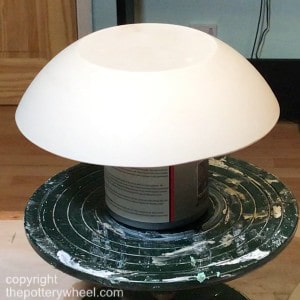
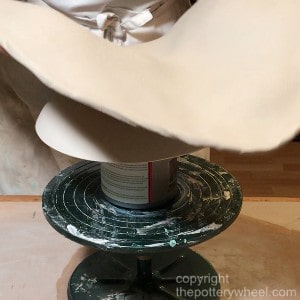
Then press the clay gently but firmly around the mold so that it hugs the entire form. The excess clay should hang down over the edge of the mold.
Using your craft knife or needle tool cut the excess clay off from around the bottom of the mold.
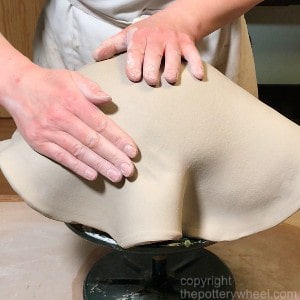
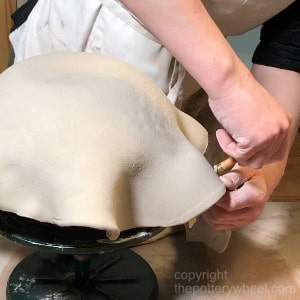
Continue to press the clay against the mold until you get a nice snug fit. Then run your knife around the bottom of the mold again to cut off the remainder of the excess clay.
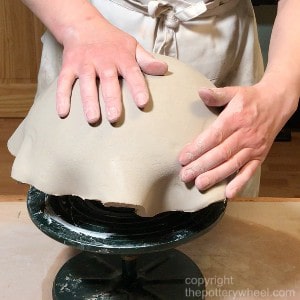
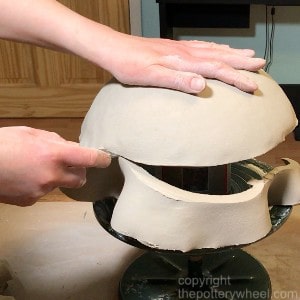
Smoothing Your Pottery
Using a metal rib or a piece of plastic like a credit card, smooth the surface of the pot. Then repeat this process with a softer rubber rib.
Finally, use your wetted fingers or a piece of damp chamois leather to finish the smoothing process.
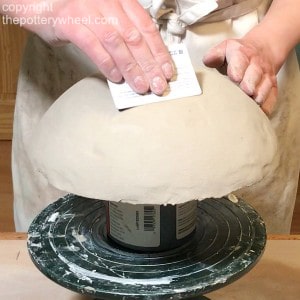
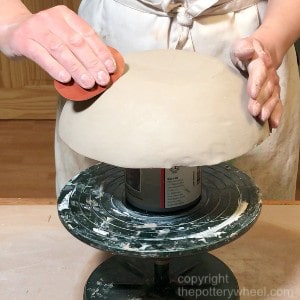
Drying Your Pottery
Leave your pot to go leather hard, and then remove it from the mold. I’d recommend drying your pottery on the mold slowly.
It will shrink around the mold and this creates quite a bit of tension in the clay. If you dry it too quickly, the clay can crack like this dish below.
To avoid this happening, cover your clay loosely with a plastic bag. Over the next few days, gradually loosen the bag and let more air in around your clay.
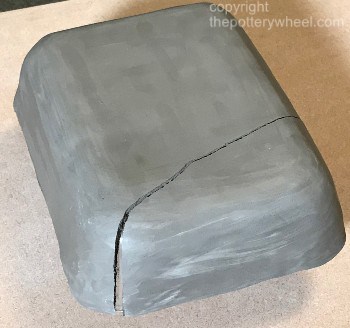
Adding Feet or a Foot Ring
Whilst the clay is on the mold you can add feet or a foot ring if you want. This isn’t essential, and you may prefer to have a flat base. However, if you do want to add a foot ring, you can do it now. I described how to make a foot ring here.
Top Tip on Making a Level Foot Ring
Once you have put your foot ring on your pot, place a piece of board onto the foot. Look to see if the board is level. You can eyeball this, or you can use a spirit level.
If it isn’t level, you can tap the part of the board that is higher than the other. If you do this whilst the ring is still workable, then you can level it out. This means your bowl will sit flat once fired.
Finishing Your Hump Mold Pottery
When the bowl is leather hard, you can tidy it up. Use a kidney rib to smooth out the surface.
You will also need to tidy up the rim by smoothing it down and compressing it. This can be done with your fingers, a sponge, or a piece of chamois leather.
I tend to use all three. First, I smooth it out with my fingers. Then use a damp sponge. Finally, I will finish the piece off with a piece of wet chamois leather. Remember not to make the lip too wet.
You need enough moisture to smooth it down. But don’t introduce too much water back into parts of your pot. If the rim gets very wet, and the base stays drier, then it sets up a drying gradient. This can cause your pot to crack as it dries completely.
Once you have finished your hump mold pot, you can decorate it as you choose.
How to Use a Slump Mold
Though they sound similar, the hump mold and slump mold approach to hand building pottery without a wheel do differ.
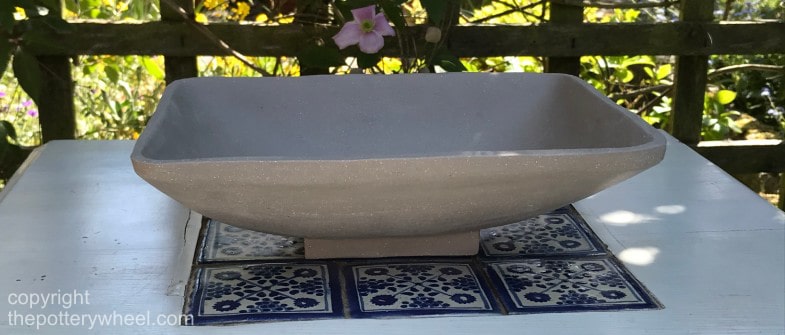
With a hump mold, you are draping your clay over a mold. By contrast, with a slump mold, you are draping your clay slab into a container.
The idea behind using a slump mold is that you drape the clay over the top edge of a container. As such, the clay slab sags into the center of the container to create a nice even curve shape.
You can use any sized container that you like. This can be anything from a yogurt pot to a bucket.
The Steps to Using a Simple Slump Mold
Select the container that you want to use as your slump mold. Roll out a slab of clay large enough to easily cover the lip of the container.
Gently lift your slab and hold it above the container. Lower the slab carefully onto the lip of the container.
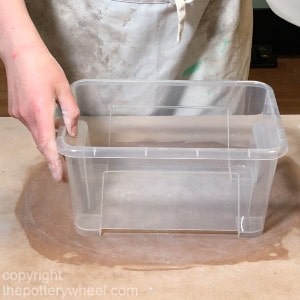
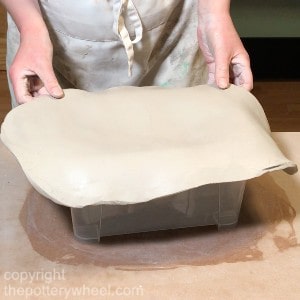
Once the clay layer is resting on the lip, lift the edges and lower it into the container. The clay slab will start to sag (slump) into the container/mold.
Once the slab is resting on the rim of the container, press the clay onto the rim. You need to press hard enough to make sure the clay doesn’t fall into the container. However, not so hard that the clay is going to get firmly stuck on the rim.
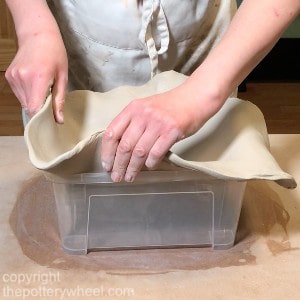
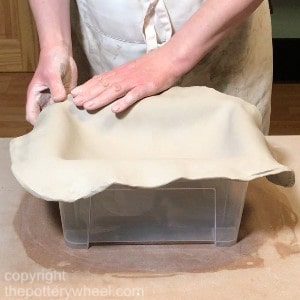
Fill an old sock with uncooked dry rice and tie it at both ends. Then use the curved part of the sock to gently tap the clay down in the slump mold. Keep tapping until you have achieved the curve that you want.
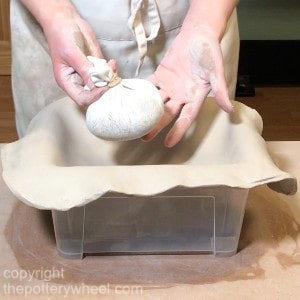
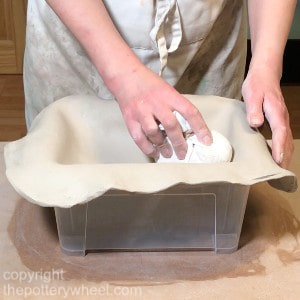
Once you have the shape that you want, trim off most of the excess clay from around the rim. I tend to do this in two steps. Cutting it off wide to start, and then closer on the second pass.
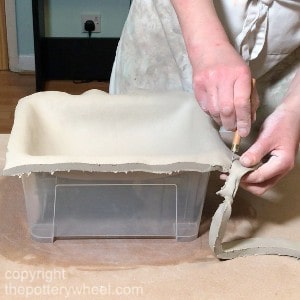
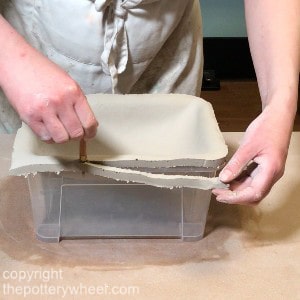
Tidy up the edges of the clay with a rubber rib and smooth out any little irregularities that you can. Then you can leave it loosely covered to become leather hard.
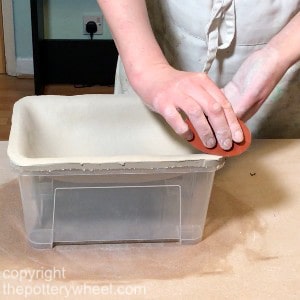
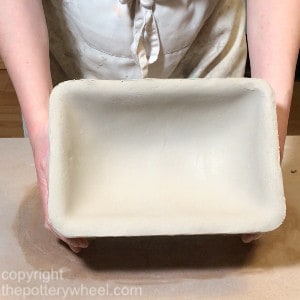
After 24 hours check to see if the clay is leather hard. Be aware that the clay underneath, inside the container is likely to be moister. So, it may take a little longer to reach leather hard stage with this slump mold method.
Once leather hard, take the clay out of the mold and place it face down on a work table. Then using a cutting tool, trim off the excess clay around the lip. Once the feet have been attached and you are finishing your pot you can tidy up the lip. I have described how to do this here.
Attaching the Foot Ring or Feet
You can fix a foot ring or feet onto your pottery at this point. The best way to do this is to cut your foot ring or feet to size. Then put the ring or feet loosely in place, and wrap the whole thing in a bag.
Leave the pot and the foot ring or feet overnight in the bag, so that they achieve even moisture content. Once the pot and the feet are leather hard, then you can attach the feet using slip and score.
How to Make Pottery Without a Wheel – Slab Pots
Here is the fourth and final way of hand building pottery without a wheel…
Making a Slab Pot
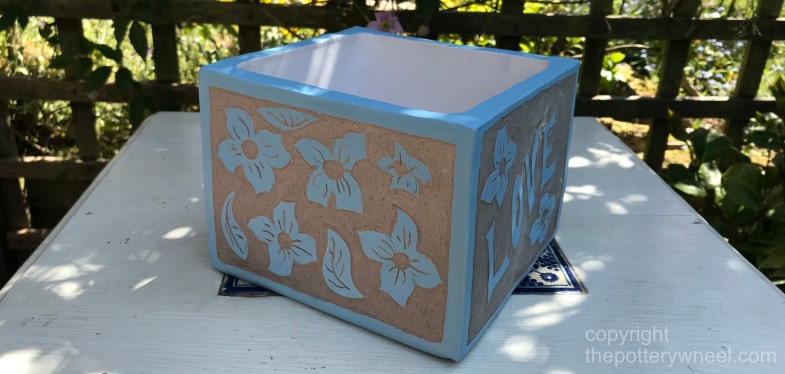
Slab pots are another very simple but satisfying way of making pottery without a wheel. You can make a range of shapes, however, slab pots are often square, rectangular, or cylindrical. I will describe here how to make a square slab pot.
What You Will Need:
- Clay
- A roller
- Wooden battens or roller guides
- A clay cutter, either a craft knife or needle tool
Steps to Making a Slab Pot:
Decide how large you want your slab pot to be.
Then cut out a template for your sides and base. You can make your template out of cardboard or paper. If you make it out of craft foam, you can use your template again and again. If you want to know more about how to make slab pottery templates, you can check out my article on template making here.
When you are making your templates, you need to account for the thickness of the clay in your measurements.
For example, let’s assume your base is 7” square and your slabs are ½”wide each. Two of your sides need to be 7” wide. And the other two need to be 6” wide.
The reason for this is that two sides can be joined to the whole length of the base. The other two sides will slot in between the longer sides. Have a look at these pictures to work out how long you need each side to be.
Roll your clay into a slab using wooden battens or roller guides.
Cut out four walls for the pot, and your base. You may want to put a lid on your pot. If you do, then you can use the base template to cut out a lid too.
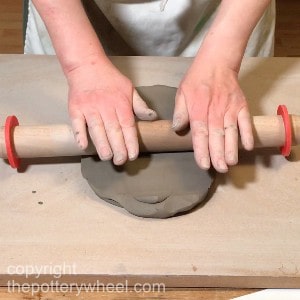
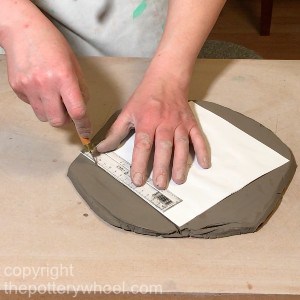
Joining the Slabs
First, you attach one wall to the base of your pot. To ensure that the wall is attached firmly, scratch the edges where the two slabs will join. Then paste on some slip to the scratched surfaces.
Press the edges the scored edges together as firmly as you can without distorting the shape of your slabs. Then, take a thin roll of clay and press this into the inside edge of the join.
Wipe away any slip that has squished out from the join. Using your thumb or a wooden tool, blend the roll into the base and wall to reinforce the join.
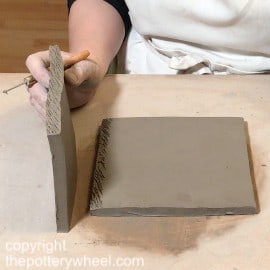
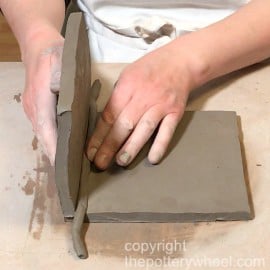
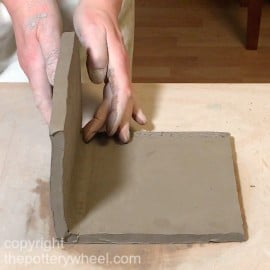
Repeat this process for all four sides. You will of course need to score, slip, and join the sides of your box as well as the base. Remember to reinforce each join by blending in a small roll of clay.
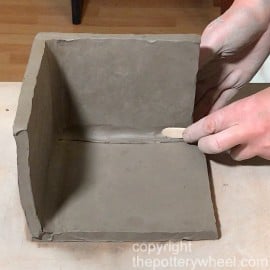
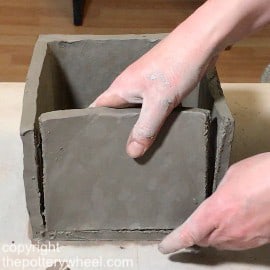
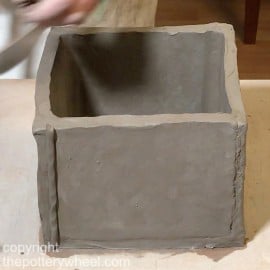
Once your slabs are joined together, wipe away any excess slip from the joins. You can also carefully smooth out the surfaces of your pot with a piece of plastic card and/or a ribbing tool. At this point the pot is relatively fragile, so be gentle when you are smoothing.
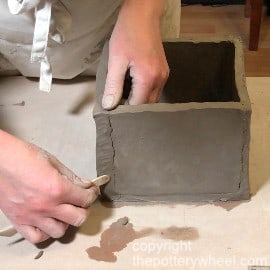
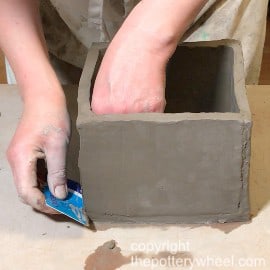
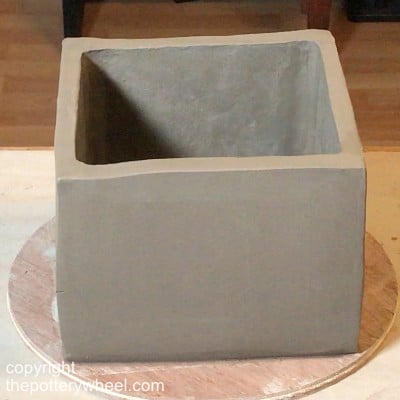
Allow the pot to become leather hard overnight. Once the pot is leather hard, it will be a bit sturdier. You can finish off any smoothing that you need to do to the sides, edges, and rim.
Decorating your Slab Pot
Because slab pots have lovely smooth flat surfaces, they are great for incising designs. Incising means cutting designs into your clay with a scoring tool.
You can decorate your slabs after you have cut them out and before you join them together. Or you can wait until your clay is leather hard and incise it then. It’s really up to you.
If you decorate before assembling the pot the clay will be softer and easier to shape. However, if you incise when your clay is leather hard, you can have a go at a technique called sgraffito.
Sgraffito involves painting your leather hard clay with colored slip or underglaze. Then, once the underglaze is touch dry, you can carve through to expose the clay body underneath.
Final Thoughts on Making Pottery Without a Wheel
This article is by no means an exhaustive account of how to make pottery without a wheel. Clay is very versatile and can be very forgiving. The steps above are suggestions and a great starting point. I would encourage you to be creative and adapt these methods to suit your own personal style.
References:

